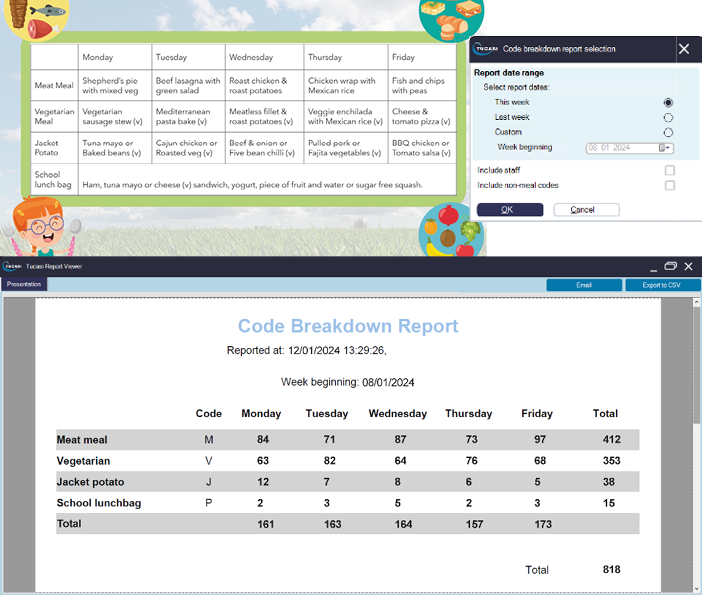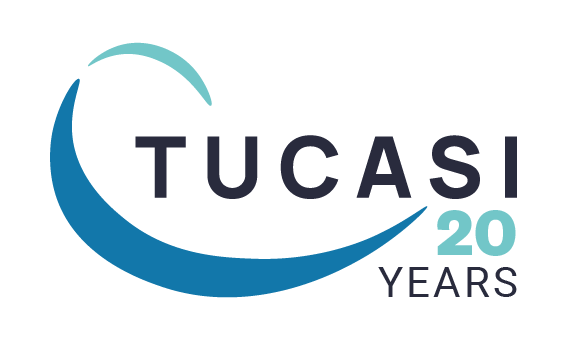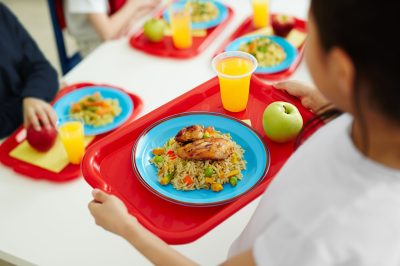Free School Meals (FSM) provide crucial support to over two million UK school children and their families. Unsurprisingly, considering the financial challenges of recent years, the total number of pupils claiming benefits-related Free School Meals has risen year-on-year since 2017/18.
Did you know? 11% of FSM eligible school children have not yet taken up the offer, according to the latest DFE data.
Benefits of Free School Meals
Free School Meals benefit pupils, and schools too, in many ways beyond the simple financial support they provide to disadvantaged families.
Health
School dinners are healthier than the average packed lunch. Just 1.6% of packed lunches meet the Government’s School Food Standards. They are less likely to contain fruit and vegetables and more likely to contain saturated fat, snack foods, sweets and sugary drinks than Free School Meals.
School meals are also proven to help reduce obesity. The introduction of Universal Infant Free School Meals (UIFSM) in the UK led to lower obesity rates.
Mental wellbeing
The security offered by Free School Meals can greatly improve pupils’ mental wellbeing. Children from food insecure households are more likely to suffer with mental health problems. Teachers often see signs of anxiety in children who come to school hungry, according to a 2022 survey.
Also, we all know that children are sponges; it’s easy for them to pick up on tensions at home and see the cost of their packed lunches or self-funded school meals contributing to their parents’ problems.
Attainment
Hunger also has detrimental effects on pupils’ behaviour. An overwhelming majority of teachers feel that hungry children tend to be excessively tired, distracted, and disruptive in school.
Unsurprisingly then, after the introduction of UIFSM, teachers reported that pupils’ behaviour, concentration and readiness for learning all improved.
So, with all these advantages, why are 11% of eligible children still not claiming their Free School Meals?
Lack of awareness of Free School Meals
Some parents don’t realise that their child meets the criteria to receive Free School Meals.
Children in state-funded schools are eligible for UIFSM throughout reception, year 1, and year 2. Therefore, parents are unlikely to look into the issue during these years. When their child transitions to year 3, they may assume their options are to start paying for school meals, or switch to packed lunches, which are often seen as the cheaper option.
This is especially likely in schools where fewer pupils are eligible, so Free School Meals aren’t often discussed within school community. The issue can be further compounded in the case of families whose circumstances change in the middle of a child’s schooling.

Stigma around Free School Meals
Social stigma may be the greatest factor for parents who knowingly choose not to claim their child’s Free School Meals.
Whether they fear adverse effects on the child’s relationships with classmates, or being personally embarrassed at the school gate, means-tested free meals are a delicate subject for many parents. Although Free School Meals are a positive, highly effective means of support for children from low-income households, some are reluctant to accept such targeted support and these attitudes can be firmly entrenched.
Misconceptions about Free School Meals

Another factor in families not taking up Free School Meals is their concern over the quality or taste of the meals themselves. From their own childhood experiences, some parents may have biased ideas about the school meals on offer; seeing them as low-value and unappetising.
These ideas endure despite the thorough School Food Standards which meals must meet. The reality is that school meals are much more nutritious and well-balanced than most packed lunches.
Additionally, parents of picky eaters or children with special dietary requirements may prefer to provide a packed lunch of familiar or ‘safe’ foods, rather than trying school meals which are outside of their control.
Action plan for schools to increase FSM uptake
Schools need a multi-faceted approach to tackle all the different causes of the gap in FSM uptake. Here are some actions you can take, which not only encourage eligible families to claim Free School Meals, but also increase interest in school lunches overall, so that other pupils may switch to paid school meals too.
Improve communication
- Send parents communications about Free School Meals at the start of each term, as well as regular reminders throughout the year. This helps to ensure that parents are aware of the support available, should their circumstances change. Schools using our online meal ordering system can also remind parents that they can easily view the school meals available on any given day through their SCOPAY account.
- Vary your methods to communicate with parents: create a page on your website, include information in your newsletter, and periodically send letters, emails or text messages. Schools using our SCOPAY system can download our free poster to send electronically or print and display in school.
- Use the monetary value of school lunches to get parents’ attention. Depending on your area, Free School Meals could save families up to £500 per year. Make sure to let them know!
- Invite a two-way conversation. You could undertake a survey to help you identify what the barriers are in your school. It may also help to speak to parents face-to-face, by setting up an information stand at parents’ evenings.
- Nominate one or more members of staff as FSM champions. Share their name, photo and contact details on the school website, newsletter and noticeboards, so that families know who they can speak to confidentially for information and advice about Free School Meals. Reaching out to families pro-actively may also provide the encouragement needed in some cases.
- Make the next steps easy for parents, by providing the information they need to take action. Include the phone number or web link they need to apply for Free School Meals in your area.
Squash the stigma
- Parents may be reluctant to claim FSM for fear of eroding their family’s status or repercussions for their child’s relationships with their classmates. School can help to reassure parents of confidentiality by implementing robust systems designed with data protection in mind. For example, Tucasi’s Dinner Money and Online Payments systems help schools track FSM statuses and manage payments and meal bookings online, so there is no visible difference between pupils receiving free or paid school meals.
- To some parents, simply accepting a helping hand can be difficult. In this case, schools might try to change tack all together, and explain that by applying for FSM, they would be helping the school to access much-needed funding. Parents may be happier to claim their child’s entitlement If they feel they are helping to bring Free School Meal and Pupil Premium funding to the school.
- Communicate the positives of Free School Meals by bundling it together with the benefits of Pupil Premium. Reluctant parents may be persuaded by learning that claiming FSM unlocks Pupil Premium funding, enriching their child’s school experience. Explain how your school uses this funding – whether that’s for trips, clubs, kit, extra-curricular resources, or anything else.
‘Sell’ your Free School Meals
- Increasing the appeal of school meals must start with the meals themselves. Schools and caterers should work to create interesting, varied, healthy meals which parents value and children are excited about.
- There are many ways to work towards this. Involve pupils in menu development, conduct surveys, or hold tasting sessions to learn which dishes are most popular. Collect data during the year through a feedback form or suggestion box. This will also help kitchens to improve pupils’ experiences. It’s important to consistently offer multiple options, catering to different tastes and dietary or cultural requirements. Analysing pupils’ choices can then inform future menus. The Code Breakdown Report in our Dinner Money module helps to quickly evaluate the popularity of each meal option. You should also consider running one-off special menus with varied themes throughout the year. This can generate a lot of buzz around what the kitchen is cooking up!
- Properly advertising your school meals can greatly increase uptake, both amongst FSM eligible and paying pupils. Schools and caterers should regularly share information with pupils and parents about their lunch menus, including nutritional information, seasonal changes, and one-off special menus.

The Code Breakdown Report helps to analyse the popularity of different meal options
- Highlight the quality and value of the free meals on offer in your marketing. Make sure to include the financial cost of the meal, which self-funded pupils would pay. You should show that FSM-eligible and paying pupils receive the same meals. This helps to overcome historic beliefs about Free School Meals being a sub-standard option.
- It’s true what they say – we eat with our eyes first! Include well-shot photographs of your dishes to show parents and pupils exactly what they can
- expect from daily meals. Our Dinner Money module enables schools and caterers to share pictures within the online ordering system. You needn’t be a professional food photographer to get some attractive snaps – take a look at our top tips.
- Go one step further and invite parents to join the children for lunch on one day each year. Letting them try the food for themselves will certainly put any concerns to rest about the quality of the free meals your school is serving.
- Running occasional promotions will also help to raise interest in school lunches. For example, schools could run an annual Free School Meals Day, providing free meals to the whole school. This is an inclusive way to offer a taster of the dinners on offer. Therefore, it may help to reassure parents who are wary of the stigma around FSM.
- Look further than the food itself to really make Free School Meals a more attractive option. Improving your dining hall or canteen environment helps pupils to enjoy their lunchtime experience. This encourages children to really appreciate the food you’re serving them, rather than wolfing down a sandwich so they can get back to the playground sooner. Dining areas should be welcoming, comfortable, sociable and eating should not be rushed. Schools are all unique, so the steps to improvement will differ from one to the next. However, consideration should be given to: refreshing the layout of your dining area and possible family-style dining to encourage more socialisation; ensuring the lunch room is kept clean, tidy and attractive, so it is a nice place to spend time; implementing pre-ordering systems and possibly staggering lunch times to reduce overcrowding and queuing, and prevent pupils from feeling rushed while eating.



